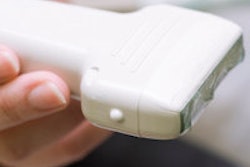An ultrasound scanner costing less than 50 euros to manufacture and designed for neonatal examinations has been developed by engineers at Newcastle University in the U.K.
The handheld USB device, roughly the size of a computer mouse, uses pulses of high-frequency sound to create an image of a fetus on a computer screen, according to designers Jeff Neasham, a senior lecturer in electrical and electronic engineering, and research associate Dave Graham. It produces an output power that is 10 to 100 times lower than conventional ultrasound units, and only requires a computer with a USB port to work. The signal works by manually moving a transducer over the skin while a focused image is formed by PC software. It is designed to complement rather than replace high-performance ultrasound scanners.
The scanner was designed with the idea of making a device that would be portable, easy to use, and affordable for use in developing countries. It was funded through a grant from the U.K. Engineering and Physical Sciences Research Council, and a proof-of-concept loan from venture capital firm NorthStar Ventures of Newcastle.
The scanner was tested by the Regional Medical Physics Department of the Freeman Hospital, part of the Newcastle upon Tyne Hospitals NHS Foundation Trust.



















